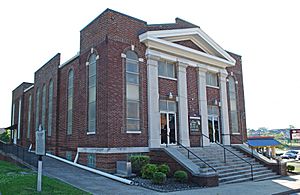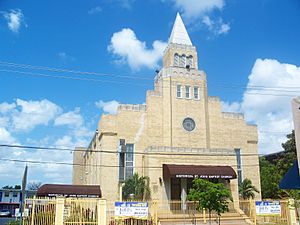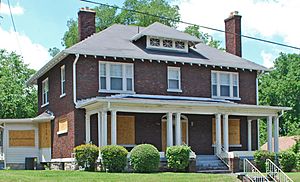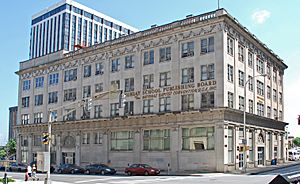- This page was last modified on 17 October 2025, at 10:18. Suggest an edit.
McKissack & McKissack facts for kids

Capers C.M.E. Church, Nashville; built in 1925

St. John's Baptist Church, Miami; built in 1940
McKissack & McKissack is a famous American company. It specializes in architecture, engineering, and construction. This means they design and build many different kinds of buildings and projects.
The company is based in Washington, D.C.. It is known for being the oldest architecture and construction company in the United States owned by a minority group.
The firm started in 1905 in Nashville, Tennessee. It was founded by Moses McKissack. His grandfather was a slave who came from West Africa and made bricks. Moses McKissack III, the grandson, became a skilled carpenter. He later teamed up with his brother, Calvin McKissack, to start the company.
McKissack & McKissack has worked on many important projects. These include the Carnegie Library at Fisk University (built in 1908). They also helped with the Nationals Park baseball stadium. Other projects include the National Museum of African American History and Culture and the Martin Luther King Jr. Memorial. They also worked on the Obama Presidential Center in Chicago.
The company has also helped update airports. These include JFK and LaGuardia in New York. They also worked on O'Hare and Midway in Chicago. In Washington, D.C., they worked on Ronald Reagan Washington National and Dulles airports.
In 2019, a major construction magazine, Engineering News-Record, recognized the company. It was named a top firm for managing large projects and construction.
Contents
Company History: Building a Legacy
The company was started by two brothers, Moses McKissack III and Calvin Lunsford McKissack. They were born in Pulaski, Tennessee. Their father and grandfather were also skilled builders.
Moses McKissack III was born on May 8, 1879, and passed away on December 12, 1952. Calvin Lunsford McKissack was born on February 23, 1890, and passed away on March 2, 1968.
Early Beginnings and Education
Moses McKissack started learning about architecture in 1890. He worked as an apprentice for a builder in Pulaski. He helped with designs, drawings, and building work. He went to Pulaski Colored High School.
Calvin McKissack went to Barrows School in Springfield, Massachusetts. He also studied at Fisk University in Nashville from 1905 to 1909. Both brothers earned their architecture degrees through special correspondence courses.
First Projects and Growth
Between 1895 and 1905, Moses McKissack built homes in different cities. These included Decatur, Alabama, Mount Pleasant, and Columbia, Tennessee. In 1905, he got a big job. He was asked to build a new house for a dean at Vanderbilt University in Nashville.
He then opened his first architecture office in Nashville. He quickly got more jobs designing and building homes. The company's first major project was the Carnegie Library at Fisk University. This building was designed in a classic style with brick and stone columns. Its cornerstone was laid in 1908 by William Howard Taft, who was then the U.S. Secretary of War.
In the 1910s, Moses McKissack designed more important buildings. These included the main building for the Turner Normal and Industrial School for Negroes in Shelbyville, Tennessee. He also designed dorms for Roger Williams University and Lane College. By 1920, he was designing buildings all over Nashville. He designed many homes in the Colonial Revival style between 1918 and 1922.
Calvin McKissack worked with his brother in Nashville. In 1912, he started his own company in Dallas, Texas. He focused on designing dormitories and churches. In 1915, he returned to Tennessee. He became a teacher of architectural drawing at the Tennessee Agricultural and Industrial State Normal School. Later, he became a director at Pearl High School.
Forming the Partnership
In 1921, Tennessee started requiring architects to be registered. The McKissack brothers became some of the first registered architects in the state. At first, some officials were unsure about letting them take the exam. But the brothers passed easily, showing their great skill.
In 1922, Calvin McKissack joined his brother. They officially formed the company McKissack & McKissack. In 1924, a group called the National Baptist Convention, U.S.A, Inc. hired them. They designed the Morris Memorial Building in Nashville. After it was finished in 1925, McKissack & McKissack moved their offices into that building.
In 1927, they designed the main library for Tennessee State University. In the 1930s, they got contracts from the Works Progress Administration. This allowed them to design several public school buildings in Nashville. These included Pearl High School and Ford Green School.
Expanding Across the Country
Around 1940, the company started to work outside Tennessee. Some states were unsure about licensing black architects. But Tennessee officials confirmed that McKissack & McKissack was a unique and skilled firm. They had done "creditable work" in Nashville, including large school buildings.
The firm then got licenses in Alabama (1941), Georgia, South Carolina, Florida, and Mississippi (1943). In 1942, McKissack & McKissack won a huge contract. It was a $5.7 million U.S. federal government contract. They were to design and build Tuskegee Army Airfield in Tuskegee, Alabama. This airfield was home to the famous Tuskegee Airmen.
This was the largest federal contract ever given to a black-owned company at that time. The project was finished successfully and on time. This brought a lot of positive attention to the company. People noted that there was no racial tension among the 1,600 workers.
In the 1940s, the firm also designed many public housing projects. Moses McKissack was even asked to join President Franklin Roosevelt's White House Conference on Housing Problems. In 1942, the brothers received the Spaulding Medal. This award recognized them as the best Negro business firm in the U.S.
Moses McKissack III passed away in 1952. A school in Nashville, McKissack Middle School, was named in his honor. Calvin McKissack continued with the firm until he passed away in 1968.
William DeBerry McKissack, Moses III's youngest son, then became president. After he became ill, his wife, Leatrice Buchanan McKissack, took over as CEO. Under her leadership, the firm won big contracts. They worked on new buildings and renovations at Fisk University, Tennessee State University, and Meharry Medical College. They also did a large renovation project for Howard University in Washington, D.C.. They designed the National Civil Rights Museum in Memphis.
Modern Expansion and New Leadership
In 1990, McKissack & McKissack opened an office in Washington, D.C. This office was led by Deryl McKissack. She is one of the three daughters of William and Leatrice McKissack. Later, offices were opened in Chicago (2002) and Los Angeles (2008).
The company's operations in Nashville ended in 2002. However, spin-off companies, led by William and Leatrice McKissack's daughters, continued in other cities. By 2013, these family-owned companies had over 150 professional staff members. They had worked on projects worth over $15 billion.
The main headquarters of McKissack & McKissack Corporate are in New York City. They also have offices in Birmingham, Alabama; Bridgeport, Connecticut; Memphis; and Philadelphia. Cheryl McKissack Daniel, Deryl McKissack's twin sister, leads the New York operations. The Washington, D.C., unit, led by Deryl McKissack, is a separate business. It also has offices in Chicago, Miami, and Baltimore.
Notable Projects and Buildings
By 1975, McKissack & McKissack had finished over 3,000 building projects. This included about 2,000 churches! Many buildings designed by the McKissack family are listed on the National Register of Historic Places (NRHP). This means they are important historical sites.
Here are some of their well-known buildings:
- Bridgeforth High School, in Pulaski, Tennessee. It is NRHP-listed.
- Cameron School, in Nashville, Tennessee. It is NRHP-listed.
- Capers C.M.E. Church, in Nashville, Tennessee. Completed in 1925, it is NRHP-listed.
- Carnegie Library, at Fisk University campus in Nashville. Built in 1908, it is NRHP-listed.
- D. R. Glass Library at Texas College, in Tyler, Texas. It is NRHP-listed.
- George Hubbard House, in Nashville. Built in 1920 in the Colonial Revival style, it is NRHP-listed.
- Morris Memorial Building, in Nashville, Tennessee. Completed in 1925, it is NRHP-listed.
- Pearl High School, in Nashville, Tennessee. It is NRHP-listed.
- National Civil Rights Museum, in Memphis.
- President's House at Texas College, in Tyler, Texas. It is NRHP-listed.
- St. John's Baptist Church, in Miami, Florida. It is NRHP-listed.
- Taborian Hospital, in Mound Bayou, Mississippi. It is NRHP-listed.
- Universal Life Insurance Company, in Memphis, Tennessee. It is NRHP-listed.


